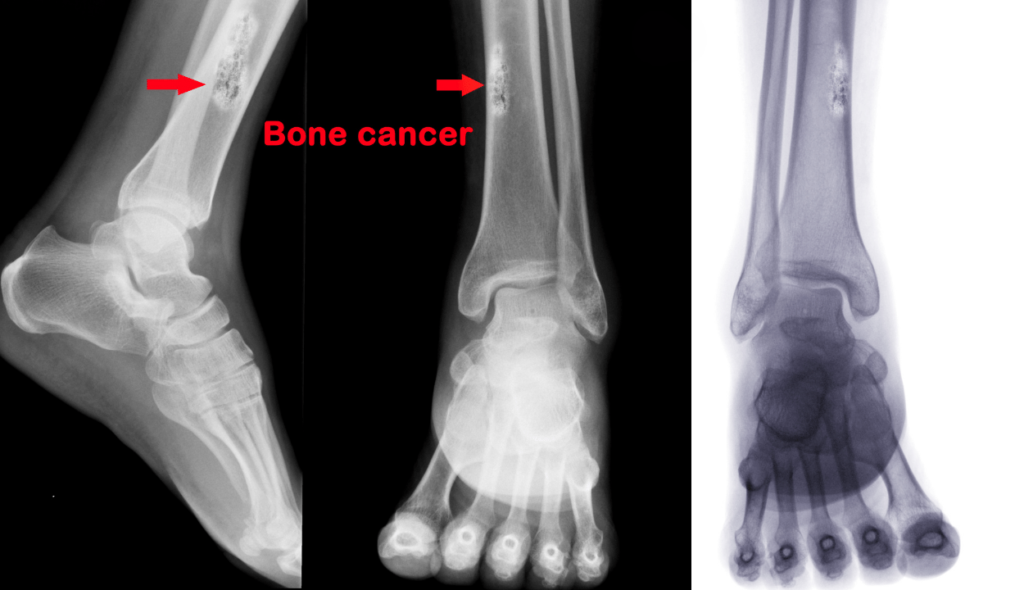Osteosarcoma bone cancer
Osteosarcoma – Bone cancer

An instance of bone cancer that starts in the cells that create bones is osteosarcoma. Although it can begin in any bone, osteosarcoma is more frequently detected in the long bones, more frequently the legs but occasionally the arms. In extremely rare circumstances, it can happen in soft tissue away from the bone.
Although it can affect younger children and older adults, osteosarcoma often affects teenagers and young adults.
Chemotherapy, surgery, and occasionally radiation therapy are used as treatments in most cases. Based on the osteosarcoma’s origin, size, kind, and grade, as well as if it has spread outside of the bone, doctors choose a course of treatment.
Over time, advancements in osteosarcoma treatment have significantly improved the outlook (prognosis) for this malignancy. It is advised that patients be monitored for the rest of their lives to look out for any potential long-term repercussions of their aggressive therapies.
The most typical cancer that begins in the bones is osteosarcoma, also known as osteogenic sarcoma. The cancer cells in these tumours resemble the earliest stages of the bone cells that ordinarily aid in the formation of new bone tissue, but osteosarcomas have weaker bone tissue than healthy bones do.
The majority of osteosarcomas affect children, adolescents, and young adults. Although teens are the age group most frequently afflicted, osteosarcoma can occur at any age.
Types of osteosarcoma
Osteosarcomas are categorised as high, middle, or low grade based on how the cancer cells appear under a microscope. The tumor’s grade informs medical professionals of the likelihood that the cancer may advance swiftly and spread to further organ systems.
High grade osteosarcoma
These osteosarcoma subtypes have the quickest rate of growth. They do not resemble normal bone when viewed under a microscope, and many of the cancer cells are engaged in cell division. Most childhood and adolescent osteosarcomas are high grade. High-grade osteosarcomas come in a wide variety of varieties.
- Osteoblastic
- Chondroblastic
- Fibroblastic
- Small cell
- Telangiectatic
- High-grade surface (juxtacortical high grade)
Other high-grade osteosarcomas include:
- Pagetoid: a tumor that develops in someone with Paget disease of the bone
- Extraskeletal: a tumor that starts in a part of the body other than a bone (but still makes bone tissue)
- Post-radiation: a tumor that starts in a bone that had once been exposed to radiation
Intermediate-grade osteosarcomas
These uncommon tumors fall between high-grade and low-grade osteosarcomas. (They are usually treated the same way as low-grade osteosarcomas.)
- Periosteal (juxtacortical intermediate grade)
Low-grade osteosarcomas
These are the slowest-growing osteosarcomas. The tumors look more like normal bone and have few dividing cells when seen with a microscope.
- Parosteal (juxtacortical low grade)
- Intramedullary or intraosseous well differentiated (low-grade central)
The grade of the tumor plays a role in determining its stage and the type of treatment used. For more on staging, see Osteosarcoma Stages.
Other types of bone tumors
Several other types of tumors can start in the bones.
Malignant (cancerous) bone tumors
Ewing tumors (Ewing sarcomas) are the second most common bone cancer in children. They are described in Ewing Family of Tumors.
Most other types of bone cancers are usually found in adults and are uncommon in children. These include:
- Chondrosarcoma (cancer that develops from cartilage)
- Undifferentiated pleomorphic sarcoma (UPS) of bone, previously known as malignant fibrous histiocytoma (MFH) of bone
- Fibrosarcoma of bone
- Chordoma
- Malignant giant cell tumor of bone
Numerous malignancies, especially those that affect adults and start in other body parts, can travel to the bones. Although they are not real bone tumours, these are occasionally referred to as metastatic bone cancers. For instance, prostate cancer that has spread to the bones is still considered to be prostate cancer and is treated accordingly.
Benign (non-cancerous) bone tumors
Not all bone tumors are cancer. Benign bone tumors do not spread to other parts of the body. They are usually not life threatening, and surgery can often remove them completely. There are many types of benign bone tumors, including:
- Osteoma
- Chondroma
- Osteochondroma
- Eosinophilic granuloma of bone
- Non-ossifying fibroma
- Enchondroma
- Benign giant cell tumor of bone
- Lymphangioma
Symptoms of osteosarcoma
Bone pain and swelling
The most typical symptom of osteosarcoma is pain at the location of the tumour in the bone. The knee or the upper arm are the most typical locations for these tumours in younger persons, though they can also develop in other bones. The pain may not initially be persistent and may worsen at night. When moving about, the pain frequently gets worse, and if the tumour is in a leg bone, it can cause a limp.
Another typical sign is localised swelling, although this may not happen right away. You might be able to feel a lump or mass, depending on where the tumour is located.
Limb swelling and soreness are extremely typical in healthy, active kids and teenagers. They might not immediately prompt a trip to the doctor because they are considerably more likely to be brought on by typical knocks and bruises. This could postpone a diagnosis. Consult a doctor if your child experiences these symptoms and they don’t go away within a few weeks (or if they worsen) so that the reason may be determined and, if necessary, treated.
Adults are less likely to experience these symptoms, thus they should prompt an earlier visit to the doctor.
Bone fractures
Although fractures (breaks) are rare, osteosarcoma may weaken the bone in which it develops. Rare telangiectatic osteosarcomas are an exception, since they have a tendency to weaken bones more than other types of osteosarcoma and are more likely to result in fractures where the tumour is located.
People who have fractures near to or through osteosarcomas frequently report that a limb was achy for a few months before the fracture, at which point it became excruciatingly painful.
In brief following are the systems:
The most common symptoms of osteosarcoma include:
- Bone pain or tenderness.
- A mass or lump (tumor) that is warm and might be felt through your skin.
- Swelling and redness at the site of your tumor.
- Increased pain with lifting (if it affects your arm).
- Limping (if it affects your leg).
- Limited movement (if it affects a joint).
- Unexplained fever.
- Broken bone
Diagnosis of osteosarcoma
A comprehensive history and physical examination will be conducted first by your healthcare practitioner. They will inquire about your symptoms and medical background, such as any prior radiation therapy or whether any members of your family have a history of particular inherited problems. Additionally, lumps that might be coming out of bones will be searched for.
When making the diagnosis, your healthcare professional could also employ a few tests. These consist of:
- Blood tests: These tests can provide information about blood counts and how your organs (such as your kidneys and liver) are working. There is no blood test to detect the presence of a bone tumor.
- X-ray: An X-ray will be done to look for abnormal growths in your bones.
- Computed tomography (CT): CT uses computers to combine many X-ray images into cross-sectional views of the inside of your body. This test is used to look for any tumors in your lungs.
- Magnetic resonance imaging (MRI): MRI uses a large magnet, radio waves and a computer to create clear images of body parts. This may be ordered for more detailed pictures if an X-ray is not normal.
- Bone scan: This test uses a small amount of radioactive material injected into your body to identify bone disorders.
- ET scan: This test uses a special glucose tracer that shows the areas in your body where the glucose uptake is extra high. This tracer is often taken up in high concentrations in cancer cells.
- Biopsy: This is a procedure in which a piece of tissue from the affected area is removed so that it can be studied for cancer cells. The two most likely types of biopsy your healthcare provider will use are a core needle biopsy or a surgical biopsy.
Finding out whether the cancer cells have spread or stayed confined is the next step once your healthcare practitioner diagnoses osteosarcoma. “Staging” is the term for this. The malignancy may spread through your lymphatic system, tissues, or blood. The cancer is still referred to as osteosarcoma and not lung cancer if it spreads to your lungs. One may employ the following diagnostic instruments:
- X-ray: Organs such as other bones or your lungs will be X-rayed.
- Computed tomography: Another CT scan will also be performed. This is the best type of scan for evaluating your lungs.
- PET-CT: This test combines the images from the CT scan and a PET scan.
- MRI: Another MRI may be needed to get detailed pictures of other sites of cancer.
- Bone scan: A bone scan will see if the cancer cells have spread to other bones.
Treatment of osteosarcoma
Most common treatment options are:
Surgery:
The damaged bone will have the tumour and some surrounding healthy tissue removed during surgery. Surgery may usually be performed on an arm or leg without having to amputate it. It is referred to as limb-salvage surgery. Those whose cancer has not spread past the primary site may be candidates for these procedures. To restore the bone that was removed during surgery, artificial implants or bone harvested from another area of your body may occasionally be utilised. Unfortunately, there are occasional situations where an arm or limb must be completely amputated. After that, you’ll receive an artificial limb or prosthesis.
Chemotherapy:
Drugs are used in this manner to eradicate cancer cells. Prior to surgery, chemotherapy is administered to reduce the size of the tumour and eradicate any cancer cells that may be present in the blood. Chemotherapy is also administered following surgery to remove any remaining cancer cells. Neoadjuvant chemotherapy, which is what it is known as before surgery, normally lasts 10 weeks. Adjuvant chemotherapy refers to chemotherapy administered following surgery to eradicate any cancer cells still present. Adjuvant chemotherapy for osteosarcoma typically lasts an extra 18 weeks.
Radiation therapy:
Osteosarcoma can occasionally be treated with radiation. This is especially crucial in regions where surgery is not an option. Radiation therapy comes in two varieties: external and internal. The external form makes use of a device that directs radiation at the diseased part of the body. Injecting the material using a needle or catheter is known as internal radiation treatment. Some individuals with osteosarcoma are treated with bone-seeking radiopharmaceuticals (samarium or radium), which are absorbed by the cancer cells that cause the disease and deliver radiation directly to the site of the malignancy.
Targeted therapy:
Utilizing medications that stop the activity of certain proteins vital to cancer cells is known as targeted treatment. Unlike chemotherapy or radiation, these medications often don’t kill normal cells as much. The most widely utilised medications include kinase inhibitor therapy, mammalian target of rapamycin inhibitors, and monoclonal antibody therapy.
Cryosurgery:
Liquid nitrogen is used to freeze and destroy cancer cells.
Amputation:
Amputation is the surgical removal of a limb. This is rare.
Rotationplasty:
The distal femur, or the part of the leg just above the knee, is where cancers are treated with this surgery. The lower leg is rotated 180 degrees and reattached utilising the ankle as a new knee after the tumour has been excised and a portion of it has been amputated. This makes the above-knee amputation more functional and makes it easier to fit a prosthesis. If a rotationplasty is an option, your doctor will go over the cosmetic side effects with you.
Take second opinion on osteosarcoma
- Comments Closed
- June 29th, 2022



Latest Posts
- Targeting FGFR4 and CD276 with CAR T-cells demonstrates a strong antitumor impact against children rhabdomyosarcoma
- Disruption of CD5 on CAR T Cells Enhances the Effectiveness of Anti-Tumor Treatment
- The future of gene therapy: What to expect in the next decade?
- Unlocking the genetic code: The future of gene therapy for genetic disorders
- CRISPR and gene editing: Revolutionizing gene therapy
- Aids cancer (4)
- Anal cancer (8)
- Anemia (5)
- Appendix cancer (3)
- Basal cell carcinoma (1)
- Bile duct cancer (7)
- Bladder cancer (10)
- Blog (3)
- Blood cancer (56)
- Bone cancer (11)
- Bone marrow transplant (43)
- Brain Tumor (48)
- Breast Cancer (48)
- Cancer (787)
- Cancer surgery (234)
- Cancer treatment in South Korea (341)
- cancer treatment in Thailand (331)
- Cancer treatment in Turkey (329)
- Cancer treatment in USA (328)
- CAR NK-Cell therapy (12)
- CAR T-Cell therapy (95)
- Cervical cancer (41)
- Chemotherapy (36)
- Childhood cancer (2)
- Cholangiocarcinoma (3)
- Clinical trials (5)
- Colon cancer (95)
- Coronavirus (1)
- Cosmetic surgery (7)
- COVID19 (2)
- Doctor (37)
- Drugs (19)
- Endometrial cancer (9)
- Esophageal cancer (15)
- Eye cancer (9)
- Gall bladder cancer (3)
- Gastric cancer (22)
- Glioblastoma (1)
- Gynecological cancer (2)
- Head and neck cancer (20)
- Hematological Disorders (50)
- Hospital (47)
- Immunotherapy (25)
- Kidney cancer (10)
- Laryngeal cancer (1)
- Leukemia (44)
- Liver cancer (94)
- Lung cancer (65)
- Lymphoma (44)
- MDS (2)
- Medical tourism (71)
- Medical visa (11)
- Melanoma (8)
- Merkel cell carcinoma (1)
- Mesothelioma (4)
- Myeloma (22)
- Oral cancer (13)
- Ovarian Cancer (13)
- Pancreatic cancer (39)
- Penile cancer (1)
- Procedure (19)
- Prostrate cancer (10)
- Proton therapy (26)
- Radiotherapy (35)
- Rectal cancer (57)
- Sarcoma (11)
- Skin Cancer (13)
- Spine surgery (8)
- Stomach cancer (40)
- Surgery (54)
- Systemic mastocytosis (1)
- T Cell immunotherapy (2)
- T-Cell therapy (7)
- Testicular cancer (5)
- Thoracic surgery (2)
- Throat cancer (6)
- Thyroid Cancer (14)
- Treatment (746)
- Treatment in China (646)
- Treatment in India (684)
- Treatment in Israel (586)
- Treatment in Malaysia (360)
- Treatment in Singapore (255)
- Treatment in South Korea (238)
- Treatment in Thailand (233)
- Treatment in Turkey (233)
- Uncategorized (39)
- Urethral cancer (9)
- Urosurgery (14)
- Uterine cancer (3)
- Vaginal cancer (6)
- Vascular cancer (5)
- Vulvar cancer (1)






Privacy Overview